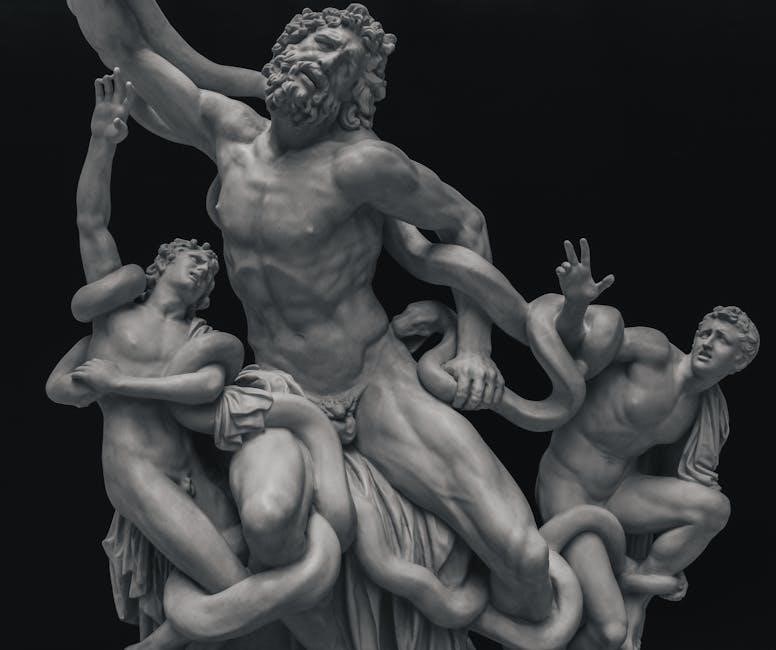Andrew Marvell’s To His Coy Mistress is a captivating metaphysical poem exploring themes of love, time, and mortality, urging seizing the moment amidst life’s fleeting nature.
Background and Historical Context
Andrew Marvell’s To His Coy Mistress was written in the 17th century, a period marked by the rise of metaphysical poetry. This literary movement, characterized by complex imagery and philosophical themes, heavily influenced Marvell’s work. The poem reflects the carpe diem motif, a common theme in 17th-century literature, urging individuals to seize the moment due to life’s brevity. Marvell’s use of metaphysical conceits and hyperbole underscores the tension between love and time, resonating with the intellectual and cultural shifts of the era. The poem’s structure, divided into three stanzas, follows a logical flow, moving from idealized love to the harsh reality of mortality, ultimately advocating for immediate action. This historical context situates To His Coy Mistress as a quintessential representation of its time, blending intellectual depth with emotional urgency.
Themes and Central Ideas
Andrew Marvell’s To His Coy Mistress revolves around the central theme of love’s urgency in the face of time’s relentless passage. The poem explores the tension between romantic idealism and the harsh reality of mortality, emphasizing the carpe diem philosophy. Marvell uses vivid imagery and metaphysical conceits to argue that delaying love is futile, as time inevitably leads to decay and death. The poem also touches on the power dynamics within relationships, as the speaker attempts to persuade his coy mistress to surrender to passion. Through its exploration of desire, time, and mortality, To His Coy Mistress delves into universal human experiences, making it a profound and enduring work of metaphysical poetry. The interplay of these themes creates a rich tapestry of emotional and intellectual depth, inviting readers to reflect on life’s transient nature and the importance of seizing the moment.
The Carpe Diem Motif
The carpe diem motif in To His Coy Mistress is a central philosophical underpinning, urging the mistress to seize the present and embrace love before time runs out. Marvell employs this motif to counteract the mistress’s coyness, emphasizing the inevitability of mortality and the fleeting nature of youth and beauty. The poem’s structure, divided into three stanzas, reflects a logical progression from idealized love to the harsh reality of time, culminating in a passionate call to action. Through metaphors like the “world enough and time” and the “youthful hue” that “must go,” Marvell underscores the urgency of living in the moment. This motif not only drives the poem’s narrative but also resonates universally, encouraging readers to cherish and act upon their desires before opportunities are lost to the passage of time. The carpe diem theme remains a powerful and enduring element of the poem’s appeal.

Poetic Structure and Form
To His Coy Mistress showcases Marvell’s mastery of poetic form, blending metaphysical conceits with precise meter and rhyme, creating a symphony of structure that enhances its themes and emotional depth.
Stanza Analysis
Andrew Marvell’s To His Coy Mistress is structured into three stanzas, each serving a distinct purpose in the poem’s argument. The first stanza idealizes love, envisioning a world with infinite time where the speaker and his mistress could savor their affection leisurely. The second stanza contrasts this fantasy with the harsh reality of time’s passage and mortality, emphasizing the urgency of seizing the moment. The third stanza becomes a passionate call to action, urging the mistress to embrace love and life before it is too late. This “if, but, therefore” structure creates a logical flow, guiding the reader from idealism to reality and finally to decision. The stanzas’ varying emotional intensities and shifting tones effectively convey the speaker’s persuasive appeal, making the poem a masterful exploration of love, time, and human desire.
Rhyme and Meter
Andrew Marvell’s To His Coy Mistress employs a sophisticated rhyme and meter scheme, enhancing its musicality and thematic depth. The poem primarily follows an ABAB CDCD EFEF rhyme pattern, with alternating iambic tetrameter and pentameter lines, creating a rhythmic flow that mirrors the speaker’s shifting emotions. This structure adds a sense of balance and control, contrasting with the passionate urgency of the poem’s content. The meter shifts subtly in the third stanza, where the speaker’s tone becomes more insistent, underscoring the poem’s carpe diem message. The blend of rhyme and rhythm contributes to the poem’s lyrical quality while reinforcing its central themes of time, love, and mortality, making it a masterful example of metaphysical poetry’s technical precision and emotional resonance.
Use of Metaphysical Conceit
Andrew Marvell’s To His Coy Mistress is renowned for its intricate use of metaphysical conceits, blending complex imagery and intellectual depth. A notable example is the comparison of the lovers’ union to “amorous birds of prey,” which vividly conveys both passion and urgency. Another striking conceit is the depiction of time as a relentless force, with the speaker’s love enduring beyond historical events like “the conversion of the Jews.” These extended metaphors, characteristic of metaphysical poetry, create a rich tapestry of ideas, linking erotic desire with philosophical reflections on mortality. By employing such conceits, Marvell elevates the poem’s themes, transforming a romantic plea into a profound meditation on life, time, and human connection, showcasing his mastery of the genre and its intellectual traditions.

Detailed Analysis of the Poem
Andrew Marvell’s poem masterfully employs a three-stanza structure to transition from idealized love to the harsh reality of time, urging immediate action with a carpe diem motif.
The First Stanza: Idealized Love
The first stanza of To His Coy Mistress presents an idealized vision of love, where time and space are limitless. Marvell uses hyperbole and metaphor to express the depth of his devotion, imagining a world where he and his mistress could spend eternity together. Lines like “Had we but world enough and time” and “I would love you ten years before the flood” emphasize the speaker’s romantic aspirations. The imagery of the Ganges and Humber rivers symbolizes vastness and eternal devotion, creating a sense of timelessness. This stanza contrasts sharply with the later sections, highlighting the tension between romantic ideals and the harsh reality of time’s constraints. The speaker’s tone is contemplative and passionate, setting the stage for the poem’s central argument.
The Second Stanza: The Reality of Time
The second stanza of To His Coy Mistress shifts from idealized love to the harsh reality of time and mortality. Marvell employs vivid imagery to emphasize the inevitability of aging and decay, contrasting the timeless fantasies of the first stanza with the finite nature of life. The speaker acknowledges that time is fleeting, and the mistress’s beauty, like all things, will eventually fade. Lines such as “The grave’s a fine and private place” and “But none, I think, do there embrace” starkly remind the reader of life’s brevity. The stanza’s tone becomes urgent, urging the mistress to act quickly before time runs out. This section heightens the tension between romantic idealism and the practical constraints of mortality, setting the stage for the poem’s final, impassioned call to action.
The Third Stanza: The Call to Action
The third stanza of To His Coy Mistress transitions from the reality of time to a passionate call to action, urging the mistress to embrace love in the present. Marvell intensifies the speaker’s argument, emphasizing the need to seize the moment before time runs out. The imagery of “iron gates of life” and “us” rolling “all together to the grave” underscores the inevitability of death and the urgency of living. The speaker rejects passive waiting, advocating for swift, mutual passion. Lines like “Let us roll all our strength and all / Our sweetness up into one ball” symbolize unity and intensity, urging the mistress to join him in embracing life’s fleeting pleasures. This stanza powerfully concludes the poem, blending metaphysical imagery with a direct, impassioned appeal to act.

Key Themes and Motifs
Central themes include the carpe diem motif, mortality, and power dynamics, exploring love’s urgency amidst life’s brevity and societal constraints, blending passion with philosophical reflection.
The Tension Between Love and Time
The poem vividly captures the struggle between the enduring nature of love and the relentless passage of time. Marvell’s speaker argues that if time were infinite, love could develop slowly and savor every moment. However, the reality of finite time creates urgency, pushing the lovers to act swiftly. This tension is emphasized through metaphors, such as the comparison of the mistress’s coyness to a crime only in the context of limited time. The speaker’s plea to seize the moment highlights the conflict between romantic idealism and the harsh constraints of mortality, making the pursuit of love both fleeting and essential.
Mortality and the Fleeting Nature of Life
Mortality and the transient nature of life are central themes in To His Coy Mistress. Marvell uses vivid imagery to underscore the inevitability of death and decay, contrasted with the urgency of living fully. The poem’s third stanza, with its dark imagery of graves and worms, starkly reminds the mistress of life’s brevity. The speaker argues that time’s passage cannot be halted, and thus, hesitation in love only leads to loss. This motif serves as a powerful reminder to embrace life’s moments, as they are fleeting and cannot be regained. The poem’s exploration of mortality not only adds depth to its romantic appeal but also underscores the universal human struggle with time’s relentless march.

Power Dynamics in Relationships
In To His Coy Mistress, Marvell explores the intricate power dynamics between the speaker and his mistress, reflecting the societal norms of courtship in the 17th century. The speaker’s persuasive arguments reveal his desire to influence the mistress’s decision, while her coyness grants her a degree of control. The poem highlights a shift from traditional courtly love to a more direct expression of desire, with the speaker using metaphors and hyperbole to assert his passion. The interplay between persuasion and hesitation underscores the tension of power exchange, where both parties navigate their roles in the relationship. This dynamic adds depth to the poem, illustrating how power can shift between individuals in pursuit of love and connection.

Style and Imagery
Andrew Marvell’s To His Coy Mistress employs rich metaphysical imagery and symbolism, blending nature and time to convey urgency and passion, with vivid metaphors and hyperbole enhancing the carpe diem theme.
Metaphor and Hyperbole
Andrew Marvell’s To His Coy Mistress is renowned for its masterful use of metaphor and hyperbole to emphasize the urgency of seizing the moment. The poem employs metaphors, such as comparing the lover’s heart to a “thousand years” of devotion, to illustrate the depth of passion. Hyperbole is used to exaggerate the extent of the speaker’s desire, as seen in lines like “I would love you ten years before the flood” and “Till the conversion of the Jews.” These literary devices not only heighten the emotional intensity but also underscore the carpe diem theme, urging the mistress to embrace the present rather than dwell on hesitation. The interplay of these elements creates a vivid imagery that compels the reader to reflect on the fleeting nature of life and love, making the poem a quintessential example of metaphysical poetry.
Simile and Symbolism
In To His Coy Mistress, Marvell skillfully employs similes and symbolism to enrich the poem’s depth and complexity. A striking simile appears in the third stanza, where the lovers are likened to “amorous birds of prey,” symbolizing their passionate yet voracious pursuit of love. This imagery conveys both the intensity of their desire and the underlying urgency driven by time’s constraints. Symbolism is also evident in the “worms” that threaten the mistress’s beauty, representing the inevitable decay of youth and the transience of life. These elements not only enhance the poem’s vividness but also reinforce its central carpe diem theme, urging the mistress to act swiftly and embrace the present moment before opportunity fades away. Marvell’s use of simile and symbolism creates a compelling narrative that resonates deeply with readers.
Imagery of Nature and Time
The imagery of nature and time in To His Coy Mistress serves as a profound backdrop for the poem’s exploration of mortality and the fleeting nature of life. Marvell vividly depicts natural elements, such as the “Indian Ganges” and the “Humber tide,” to symbolize the vastness and inevitability of time’s passage. The “rubies” found by the Ganges embody the richness of youth and beauty, while the “worms” that threaten the mistress’s “picture in the brain” evoke the decay that time brings. These natural images are intertwined with temporal motifs, creating a sense of urgency and impermanence. The contrast between the idyllic, timeless scenarios of the first stanza and the harsh realities of aging and death underscores the poem’s carpe diem theme, compelling both the mistress and the reader to cherish the present moment before it slips away.

Reception and Legacy
Andrew Marvell’s To His Coy Mistress is widely regarded as one of the greatest metaphysical poems in English literature, celebrated for its rich imagery and timeless themes of love and mortality.
Historical Reception
First published posthumously in 1681, To His Coy Mistress gained attention slowly, with initial readers often focusing on its intellectual complexity rather than its emotional depth. Over the centuries, it has been celebrated for its metaphysical style and carpe diem theme, becoming a staple in academic curricula. Early critics noted its use of metaphor and hyperbole, while modern scholars explore its deeper philosophical undertones, such as the tension between love and time. The poem’s historical reception highlights its enduring relevance, as its themes continue to resonate with contemporary readers and scholars alike.
Modern Critical Interpretations
Modern scholars have delved deeper into To His Coy Mistress, uncovering layers of meaning beyond its surface-level carpe diem theme. Feminist critics highlight the poem’s portrayal of power dynamics, suggesting the speaker’s urgency may reflect a desire to control or dominate. Poststructuralist readings explore the tension between persuasion and coercion, questioning the speaker’s sincerity. Additionally, the poem’s use of metaphysical conceits has been analyzed for its philosophical depth, particularly in how it juxtaposes the infinite with the finite. Contemporary interpretations also emphasize the poem’s relevance in discussions about mortality, consent, and the fleeting nature of human connection. As a result, To His Coy Mistress remains a rich text for interdisciplinary analysis, bridging literary and cultural studies.
Influence on Later Literature
To His Coy Mistress has left an indelible mark on literary history, inspiring generations of writers with its metaphysical style and carpe diem themes. The poem’s structure and use of conceits influenced 18th-century poets like Alexander Pope, who admired its intellectual depth. In the Romantic era, its emphasis on emotional urgency resonated with poets like John Keats. Modernist writers, such as T.S. Eliot, drew parallels with its exploration of time and mortality. The poem’s blend of wit and philosophical reflection continues to inspire contemporary poets and novelists, making it a cornerstone of literary studies and a timeless example of poetic craftsmanship. Its influence extends beyond poetry, shaping themes in novels and essays that grapple with love, time, and human existence.
Andrew Marvell’s To His Coy Mistress remains a vital exploration of love, time, and mortality, offering timeless lessons through its carpe diem motif and enduring poetic brilliance.
Andrew Marvell’s To His Coy Mistress is a masterful exploration of love, time, and mortality, structured into three stanzas with distinct emotional tones. The first stanza idealizes love, envisioning a world with infinite time for devotion. The second stanza confronts the harsh reality of time’s brevity, urging immediacy. The third stanza serves as a passionate call to action, emphasizing the carpe diem motif. Rich metaphors and hyperbole enhance the poem’s vivid imagery, while its rhyme and meter underscore the urgency of seizing the moment. This blend of philosophical depth and emotional intensity makes the poem a timeless reflection on life, love, and the fleeting nature of existence.
Final Thoughts on the Poem’s Significance
Andrew Marvell’s To His Coy Mistress remains a profound and enduring work in English literature, celebrated for its intricate blend of intellect and emotion. Its exploration of time, mortality, and love continues to resonate with readers, offering timeless reflections on human existence. The poem’s masterful use of metaphysical conceits, vivid imagery, and carpe diem themes has solidified its place in literary canon. Widely anthologized and studied, it continues to inspire critical analysis and admiration. Marvell’s ability to balance philosophical depth with passionate urgency ensures the poem’s relevance across centuries, making it a cornerstone of metaphysical poetry and a testament to the power of seizing life’s fleeting moments.

Additional Resources
- PDF Versions: Downloadable PDFs of the poem are widely available for easy access and study.
- Study Guides: Comprehensive analysis and study guides provide deeper insights into themes and structure.
- Critical Works: Essays and scholarly articles offer varied interpretations and critiques of the poem.
PDF Versions of the Poem
PDF versions of To His Coy Mistress are widely available online, offering convenient access to the poem for reading and analysis. These downloadable files often include the full text of the poem, making it easy for students and scholars to study Marvell’s metaphysical masterpiece. Many PDF versions are free and can be accessed through educational websites, academic databases, or platforms like Project Gutenberg. Some PDFs also include annotations, commentary, or study guides, providing additional context and insights into the poem’s themes, structure, and historical background. For those seeking a printable format, PDFs are an ideal choice, ensuring a clear and structured presentation of the poem. These resources are particularly useful for classroom discussions, personal study, or research purposes.
Study Guides and Analysis
Study guides and analyses of To His Coy Mistress provide in-depth explorations of the poem’s themes, structure, and literary devices. These resources often include detailed breakdowns of the poem’s three stanzas, examining the evolution of the speaker’s argument from idealized love to the harsh reality of time and mortality. Many guides highlight Marvell’s use of metaphysical imagery, such as the comparison of the lovers to “amorous birds of prey,” and the carpe diem motif that underscores the poem’s urgency. Additionally, these analyses frequently discuss the historical context of 17th-century metaphysical poetry and its influence on Marvell’s work. They also explore the tension between love and time, offering insights into the poem’s emotional and philosophical depth. These study guides are invaluable for students and scholars seeking to fully understand the poem’s complexity and significance.
Essays and Critical Works
Essays and critical works on To His Coy Mistress offer profound insights into the poem’s themes, structure, and cultural significance. Scholars have extensively analyzed the poem’s use of metaphysical imagery, such as the “vegetable love” metaphor, and its exploration of the carpe diem motif. Critical essays often delve into the tension between the speaker’s romantic ideals and the harsh realities of time and mortality. Many works also examine the poem’s power dynamics, with some feminist critics interpreting it as a reflection of patriarchal attitudes. Additionally, essays explore the historical context of 17th-century metaphysical poetry and its influence on Marvell’s work. These critical analyses provide a deeper understanding of the poem’s emotional and philosophical complexity, making them essential for academic study and appreciation of Marvell’s mastery.
